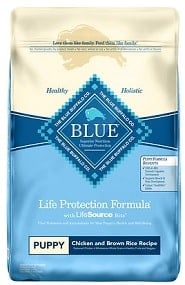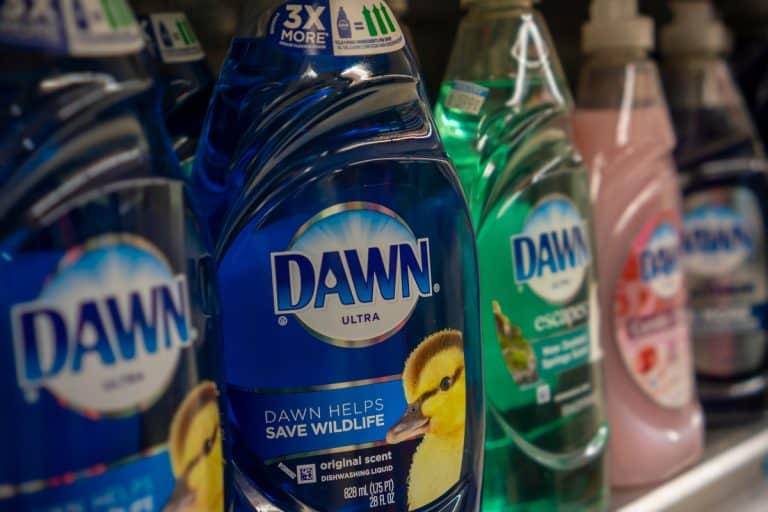Toy, Miniature, Standard Poodle Growth Chart (Weight & Size Chart)
Do you own a poodle or looking to adopt one? Understanding the poodle growth chart, whether your dog is a toy, miniature, or standard, is important.
This will prepare you to give them the best care at the different stages of their lives.
This article will give you information on when your poodle will stop growing, the weight and size chart, explain the different types of poodles, and also the common health problems associated with poodles.
When Do Poodles Stop Growing?

Each poodle type takes a different time to stop growing. The larger poodles take a longer time to reach their full weight and height.
Therefore, standard poodles will take a longer time to reach their full size than toy poodles.
Usually, toy poodles finish growing in height somewhere between 6 and 7 months of age. Some miniature poodles can take up to 12 months to finish growing, while others take between 6 to 7 months to finish growing. Standard poodles take around 2 years to finish growing.
Different Types Of Poodles
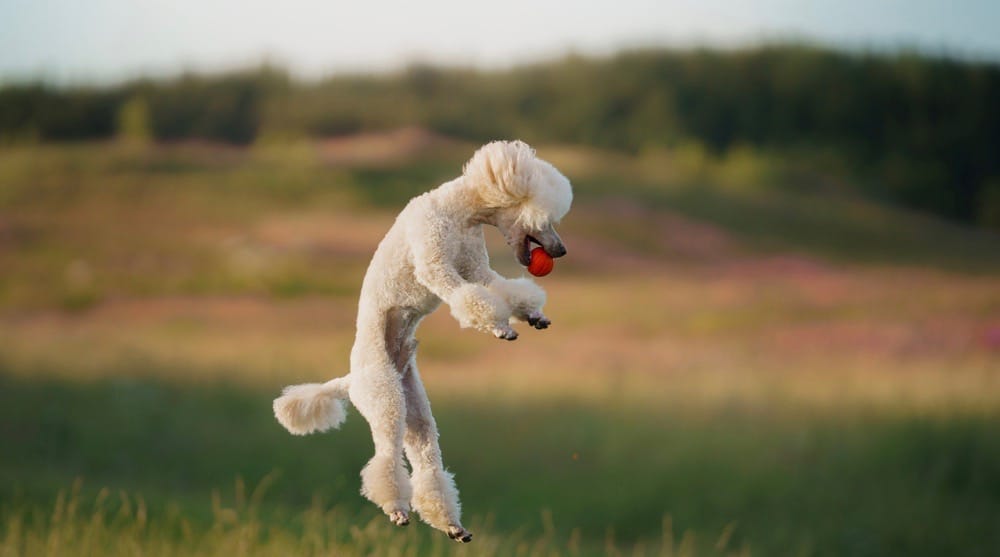
Standard Poodle Size Chart
These are the largest dogs in the category of poodles. Standard poodles are not visually intimidating but they can be great guard dogs. This is because they are brave, alert, and protective of their owners.
They are the original as they were the first to appear. Standard male poodles are bulkier than females.
Their height is at least 15 inches, but mostly they stand between 20 to 23 inches. If you look at our Poodle growth chart, you can see that they weigh between 45 and 80 pounds.
Miniature Poodle Size Chart
According to American standards, miniature poodles are mid-sized. This type of poodles has similar personalities to the standard poodles even though they are smaller than them. They make great pets for families.
Miniature poodles usually weigh between 14 to 18 pounds and are between 11 to 15 inches tall.
Toy Poodle Size Chart
The smallest of the three in the poodle category, toy poodles are great if you’re looking to have a lovable lap dog. They stand at about 8 to 10 inches tall and weigh less than 10 pounds. They are usually between 6 and 9 pounds.
Toy poodles need surprising amounts of exercise and are extremely intelligent. Even though they have the word toy in their name, toy poodles are not considered as toy dogs but as utility dogs.
Poodle Weight Chart (Toy & Miniature)
| Birth | 2.5 oz | 2.75 oz | 3.0 oz | 3.5 oz | 4.0 oz | 4.5 oz | 4.75 oz | 5.0 oz | 5.5 oz | 6.0 oz | 6.5 oz | |
|---|---|---|---|---|---|---|---|---|---|---|---|---|
| 1 week | 3.5 | 4 | 5 | 5.5 | 6.5 | 7 | 8 | 9 | 9.5 | 10.25 | 11 | |
| 2 weeks | 5 | 5.5 | 6.5 | 7 | 9 | 10 | 11 | 12.5 | 13.5 | 14.5 | 16 | |
| 3 weeks | 6 | 7 | 8 | 9 | 11 | 13 | 14 | 16 | 17.5 | 18.5 | 0 | |
| 4 weeks | 7 | 8 | 9.5 | 11 | 13 | 15 | 17 | 19 | 21 | 23 | 4 | |
| 5 weeks | 8 | 9 | 11 | 13 | 15 | 17 | 19.5 | 22 | 24 | 26 | 9 | |
| 6 weeks | 9 | 11 | 12.5 | 15 | 17.5 | 20 | 22 | 24 | 27 | 30 | 32 | |
| 7 weeks | 10 | 12 | 14.5 | 17 | 19.5 | 22 | 24.5 | 27 | 30 | 33 | 35 | |
| 8 weeks | 11 | 13 | 16 | 19 | 21.5 | 24 | 27 | 29 | 33 | 36 | 39 | |
| 9 weeks | 12 | 15 | 17.5 | 20 | 23 | 26 | 29 | 32 | 35 | 39 | 42 | |
| 10 weeks | 13 | 16 | 19 | 22 | 26 | 28 | 31 | 34 | 38 | 41 | 45 | |
| 11 weeks | 16 | 17 | 21 | 24 | 27 | 31 | 34 | 37 | 40 | 45 | 49 | |
| 12 weeks | 16 | 19 | 22 | 26 | 30 | 33 | 37 | 41 | 45 | 49 | 53 | |
| 13 weeks | 16 | 20 | 24 | 28 | 32 | 36 | 40 | 44 | 49 | 53 | 57 | |
| 14 weeks | 17 | 22 | 26 | 30 | 34 | 39 | 43 | 47 | 52 | 56 | 60 | |
| 15 weeks | 19 | 23 | 28 | 32 | 37 | 41 | 46 | 51 | 56 | 61 | 65 | |
| 16 weeks | 20 | 25 | 30 | 34 | 39 | 44 | 49 | 54 | 59 | 65 | 70 | |
| 17 weeks | 21 | 26 | 31 | 36 | 41 | 46 | 51 | 57 | 62 | 67 | 72 | |
| 18 weeks | 22 | 28 | 33 | 37 | 43 | 48 | 54 | 60 | 65 | 71 | 76 | |
| 19 weeks | 23 | 29 | 34 | 39 | 44 | 50 | 56 | 62 | 67 | 72 | 77 | |
| 20 weeks | 24 | 30 | 35 | 41 | 46 | 52 | 58 | 64 | 70 | 76 | 81 | |
| 21 weeks | 24 | 31 | 36 | 42 | 48 | 54 | 60 | 66 | 72 | 78 | 84 | |
| 22 weeks | 25 | 32 | 37 | 43 | 49 | 56 | 62 | 68 | 74 | 80 | 85 | |
| 23 weeks | 26 | 33 | 38 | 44 | 50 | 57 | 64 | 70 | 76 | 82 | 88 | |
| 24 weeks | 26 | 33 | 38 | 45 | 51 | 58 | 65 | 71 | 78 | 84 | 90 | |
| 25 weeks | 27 | 34 | 40 | 46 | 52 | 59 | 66 | 72 | 79 | 86 | 93 | |
| 26 weeks | 27 | 36 | 40 | 47 | 53 | 60 | 67 | 73 | 80 | 87 | 94 | |
| Final Adult Weight | 2.0 lb | 2.5 lbs | 3.0 lbs | 3.35 lbs | 4.0 lbs | 4.5 lbs | 5.0 lbs | 5.5 lbs | 6.0 lbs | 6.5 lbs | 7.0 lbs |
Toy Poodle Weight
Normally are 5 pounds when they are full-grown adults. During the first three to four months, they will grow rapidly before it plateaus and slows down. Toys reach their adult size by the age of 6 months.
Miniature Poodle Weight
Reach 10 pounds between the ages of 7 and 9 months. They will reach the full size of an adult during their first year.
Standard Poodle Weight
Usually, 70 pounds when they are adults. They will continue growing up to one and a half to two years, but most of the growth happens in the first year.
Toy, Miniature, and Standard Poodle Growth Chart
A poodle’s height is measured from the ground to the top of the shoulder blades. The Poodle size chart for the different types of poodles is as follows:
| Toy Poodles | Miniature Poodles | Standard Poodles | |||
| Weeks | Inches | Weeks | Inches | Weeks | Inches |
| 5 | 5 | 8 | 8 – 8.5 | 8 | 12 – 13 |
| 8 | 6 | 12 | 10 – 10.5 | 12 | 14 |
| 12 | 7 | 16 | 11 – 11.5 | 16 | 18 – 19 |
| 16 | 8 | 24 | 13.5 – 14 | 24 | 21 + |
| 20 | 9 | 24 Months | 24 – 27 | ||
| 24 | 10 | ||||
Will Neutering/Spaying Affect My Poodle’s Growth?
Neutering (male) and spaying (female) are the surgical removals of the reproductive organs. Standard Poodles should be neutered or spayed at the age of one year while Toy and Miniature Poodles should be spayed or neutered at the age of 6 months.
Neutering your Poodle has health-related benefits such as lowering the risk of prostate issues and cancer. It also has behavioral benefits such as less aggressiveness and marking of territories.
However, neutering can delay the closure of the growth plates affecting the growth of your Poodle in the future.
Spaying your Poodle reduces the risk of mammary cancer, pyometra, and increases life expectancy. Spaying needs the use of general anesthesia and major surgery which can cause complications in your Poodle.
At What Age Is a Poodle Fully Grown?
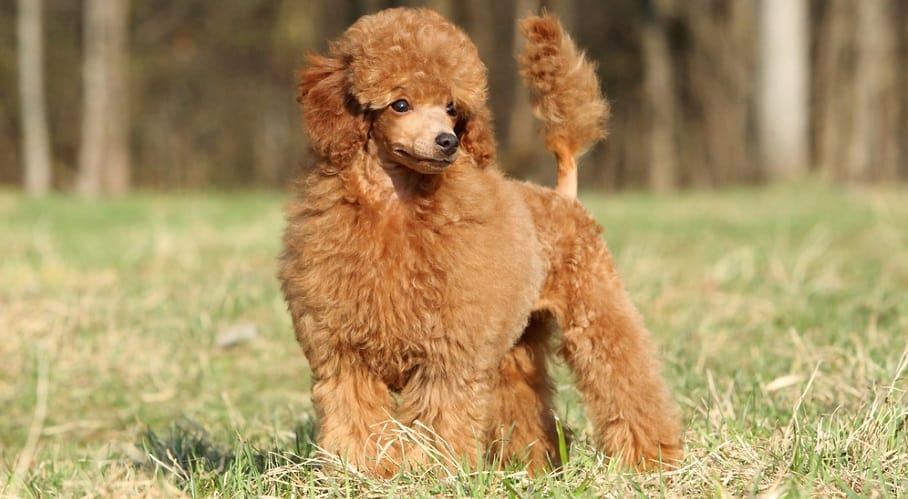
When Poodles reach the age of two years, they are fully grown and have attained their adult weight and height. At around the age of 18 months, they tend to show signs of emotional maturity.
Most Poodles will reach their adult height or close to it when they are one year old. However, they need full two years to fill up their chest and body frame.
How Big Will My Poodle Puppy Get?
There are a few ways of knowing how big your Poodle will get when they are adults. The first step is to ask your breeder to give you an estimate of your Poodle’s final weight and height based on the puppy’s past litters and parents.
Next, check your puppy’s paws. If they look oversized next to their body and legs, probably they are still filling out and will be bigger as adults.
Typically, an adult female Poodle weighs around 40 to 50 pounds while an adult male Poodle weighs between 60 and 70 pounds.
A fully grown poodle stands at a height of 15 inches from the ground to the withers. Standard Poodles have a height of between 18 and 24 inches.
How To Properly Weight & Measure A Poodle
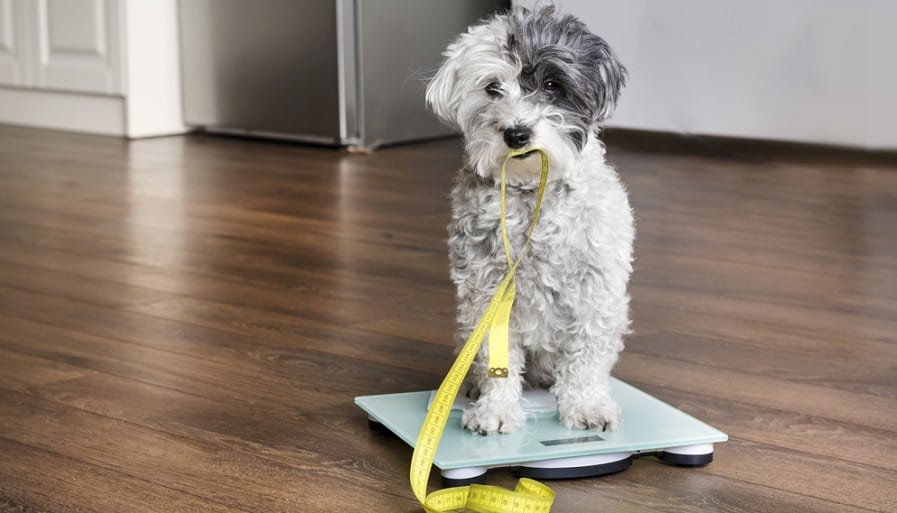
Weighing your Poodle puppy is essential in ensuring that they are maintaining a healthy weight. It is recommended that you weigh your Poodle at least once per year but weighing them every six months will help you identify any health issues earlier on.
Use your bathroom scale to find the weight of your Poodle. First, step on the scale and write down your weight.
Then, carry your Poodle, step on the scale, and record the number. To find the weight of your Poodle, subtract your weight from the total weight of your dog and you.
Measuring your Poodle’s height is also necessary for ensuring that they are healthy. Let your Poodle stand on a flat surface, preferably the ground or floor.
Find the withers which is the highest point of your puppy’s shoulders. Then use a measuring tape to measure from the ground to the withers, this is your Poodle’s height.
Poodle Body Condition Score (BCS)
Body Condition Score is a quantitative method used to measure body fat for pets. There are two types of scales for knowing the BCS of your Poodle: 1 to 5 and 1 to 9. You can use palpation and visualization to assign a BCS score for your puppy.
The ideal Poodle Body Condition Score should be 3/5 or 4-5/9. This is where the waistline and abdominal tuck are visible. The ribs are also easily palpable with only a thin layer of fat. This indicates that your Poodle’s weight is healthy.
If your Poodle is obese, their BSC will be 9/9 or 5/5 where the ribs are difficult to feel or see because of the thick layer of fat.
On the other hand, if your Poodle is emaciated, their BCS will be 1/9 or 1/5 where their ribs are visible from far because there is no fat layer.
Poodle Body Shape Changes
The body shape of the toy poodle is similar to that of the miniature and standard poodle. The only difference is height. Poodle puppies have a square appearance. The length is approximately similar to the height at the shoulder blades.
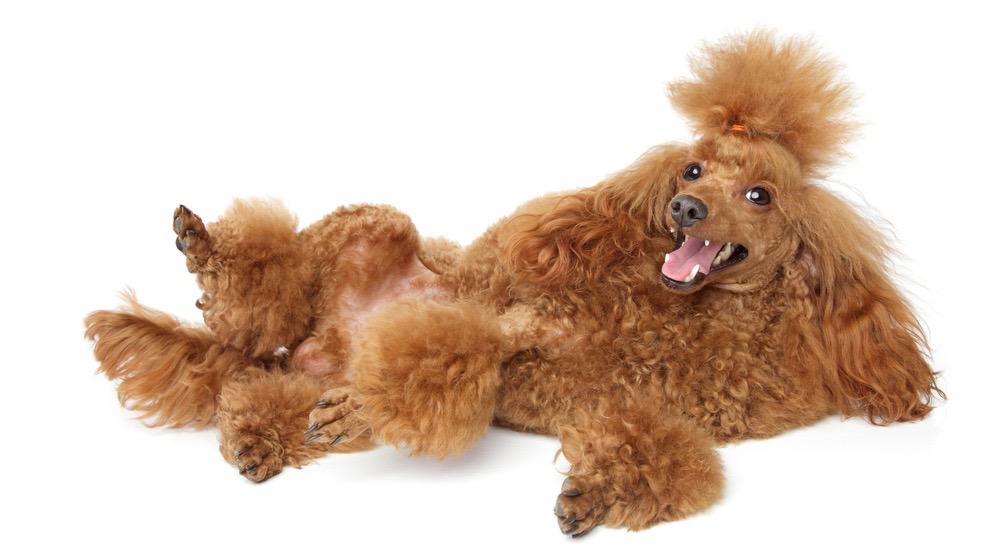 As puppies, poodles are small in size, but as they grow older, their muscles start to show.
As puppies, poodles are small in size, but as they grow older, their muscles start to show.
If you notice any body shape changes in your poodle, you should be concerned—as this could be a result of adding or reduction of weight. If you are not sure, take them to the vet for advice on what to do.
Factors That Affect Poodle Puppy Growth
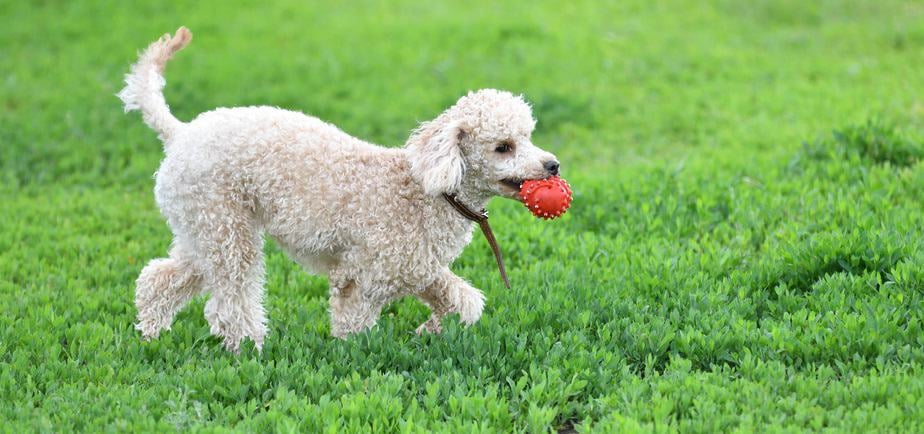
Genetics
As a puppy owner, you should know that genetics plays a key role in the growth of your pet. Therefore, it is important to know the parents and grandparents of your poodle before adopting them.
Knowing the ideal size and weight of the parents and grandparents will give you information on the size your puppy will be.
In case there are any changes in their growth you will know what to do. Print out the Poodle weight chart and keep it on hand.
Nutrition
To keep your poodle healthy and their coat curly, lush, and soft, you need to feed them a high-quality palatable diet. This is because poodles are prone to health conditions that can affect their appetite. Monitoring your poodle’s weight and diet is important to detect any of these conditions.
During their first year of life, young poodles thrive on dog food labeled for puppies. These foods contain the right percentage of proteins and fats needed for optimum growth.
Older poodles who are 8 years and above, require less fat and protein but more carbohydrates to prevent health conditions such as obesity.
Physical Activity & Health
Proper exercising for poodles will keep them in their right weight. The physical benefits of exercise for poodles include: maintenance of proper muscle tone, increase in bone strength, and can help prevent diseases such as diabetes and arthritis.
Physical activity can also improve the behavioral and social health of poodles in different ways. Exercise can help eliminate or reduce irritability or aggression, destructive behavior, excessive barking, and attention-seeking behavior.
Regular exercising can increase bonding, teach socialization and improve sleep and their overall mood. These all will lead to the healthy growth of your puppy.
How Long Are Poodles Pregnant?
If you own a poodle female, knowing the signs will help you assist her to have a successful pregnancy and process of birth. Poodles are pregnant for around 63 days and as the fetus grows, poodles go through the different stages of gestation.
When your poodle is pregnant, her nipples and stomach will enlarge as early as two weeks and she will seem more tired than usual. Behavioral signs that show your poodle is pregnant include possessiveness, lethargy, and showing maternal behaviors over toys.
The more obvious physical signs of pregnancy will start showing as from four weeks.
How Many Puppies Do Poodles Have?
Compared to their poodle counterparts, toy poodles have the smallest litter size. On average, they have three puppies in one litter. This depends on the mother and breeding circumstances. Most toys have only one puppy and though rare, a few may have up to five puppies.
Miniature poodles have a typical litter size and on average they have five puppies. The number can be influenced by circumstances. Standard poodles are bigger dogs—hence, they have larger litter sizes. On average, they can have seven puppies in one litter.
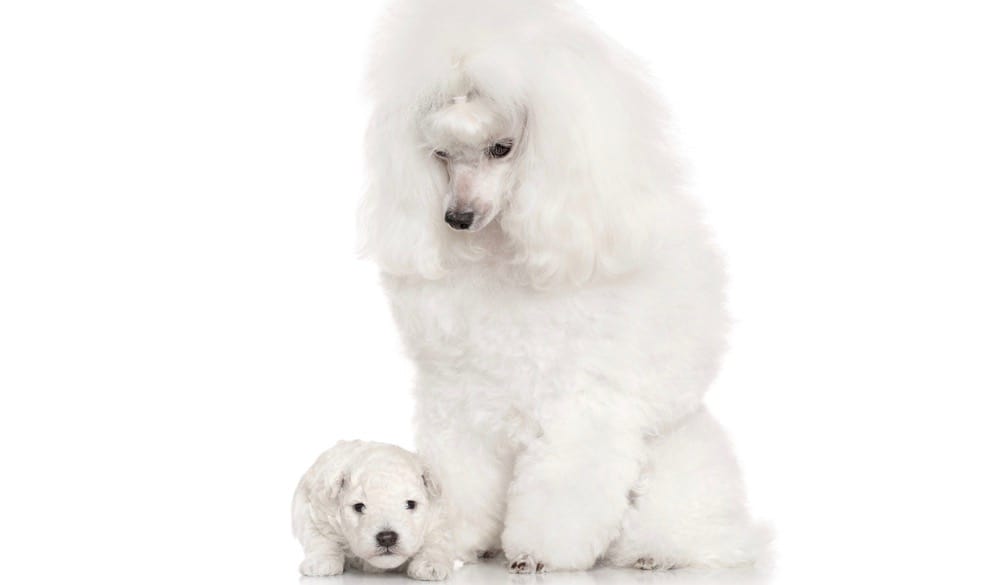
When looking to adopt a poodle puppy, find a reputable breeder and book in advance as they are in demand, and as the toy poodles, they can be small.
What If My Poodle Is Not the Right Weight?
Ensuring that your poodle has the right weight is very essential to avoid them being overweight or underweight, which can play an important role in their health.
It is important to make changes if your poodle is overweight so that they can regain their health. If you cannot feel your puppy’s ribs or notice that they have difficulty breathing when walking, then they could be overweight.
There are health risks that can affect an overweight poodle and includes: diabetes mellitus, heart disease, high blood pressure, and decreased liver function among others.
If you have concerns that your poodle is not the right weight, take them to the vet and they will be able to give you advice on what to do. They can also find if there is any underlying condition that could be causing the weight change.
You can help your poodle to lose weight by adding regular exercise to their lifestyle, controlling their food portion, and feeding them specialized food for weight loss.
On the other hand, if you want your poodle to gain weight you can add scheduled feeding to their routine, create a safe environment for them and add high-protein foods to their diet.
What Is The Life Expectancy Of A Poodle?
The life expectancy of poodles depends on the type. For instance, toy poodles are simply smaller and are in the lower end of the size group of poodles. Their life expectancy ranges from 10 to 18 years.
Miniature poodles are a size up after toy poodles and they have the same life expectancy as toys, that is, 10 to 18 years. Standard poodles are the largest puppies in the poodle breed.
Therefore, just like any other large dog, their life expectancy is lower than miniature and toy poodles. It ranges from 11 to 13 years.
How Much Does It Cost To Own A Poodle?
If you are looking to get yourself a poodle puppy, you need to consider the different expenses. These include the initial cost, training cost, veterinary costs, food, treats, supplies, license registration, microchip, and grooming. The total amount may vary depending on the expenses involved.
Miniature and toy poodles cost between $1000 to $2000 while standard poodles cost around $700 to $1500. On average the total cost of owning a poodle puppy over his lifetime is approximately $28,260.

Some factors can affect the cost of owning a poodle and they include bloodline and breeder’s reputation, registration papers/pedigree, medical expenses, and health screenings, breed popularity in your location, age as well as coat color and markings.
Poodle Genetics And Common Health Problems
Like humans and other dogs, poodles have health problems that are specific to the breed and others common to all dogs. The following are the health issues that poodle owners should be concerned with:
Addison’s disease: This is where the adrenal gland does not produce enough adrenal hormone. Early signs of this disease include lethargy, vomiting, and poor appetite.
Atrial Septal Defects in Standard Poodles: This is a rare condition where the heart has a hole in the upper chambers. ASD signs include trouble breathing, coughing, possible fainting or collapse, and exercise intolerance. Sometimes sudden death may occur due to heart failure.
Other common health problems: They include bloating, chronic active hepatitis, Cushing disease, epilepsy, hip dysplasia, and hypothyroidism.
Final Thoughts
Understanding your poodle puppy growth chart will enable you to give them the lifestyle in terms of exercise, training, and diet. It is necessary to know the ideal weight of your poodle at every stage of their lives so that they are not overweight or underweight.
It is also important to know the different health problems that can affect poodles. Being on the lookout for the signs will enable you to take them to a vet for early diagnosis to prevent any future problems.
Hopefully, the above article has given you enough information to understand your poodle puppy.

